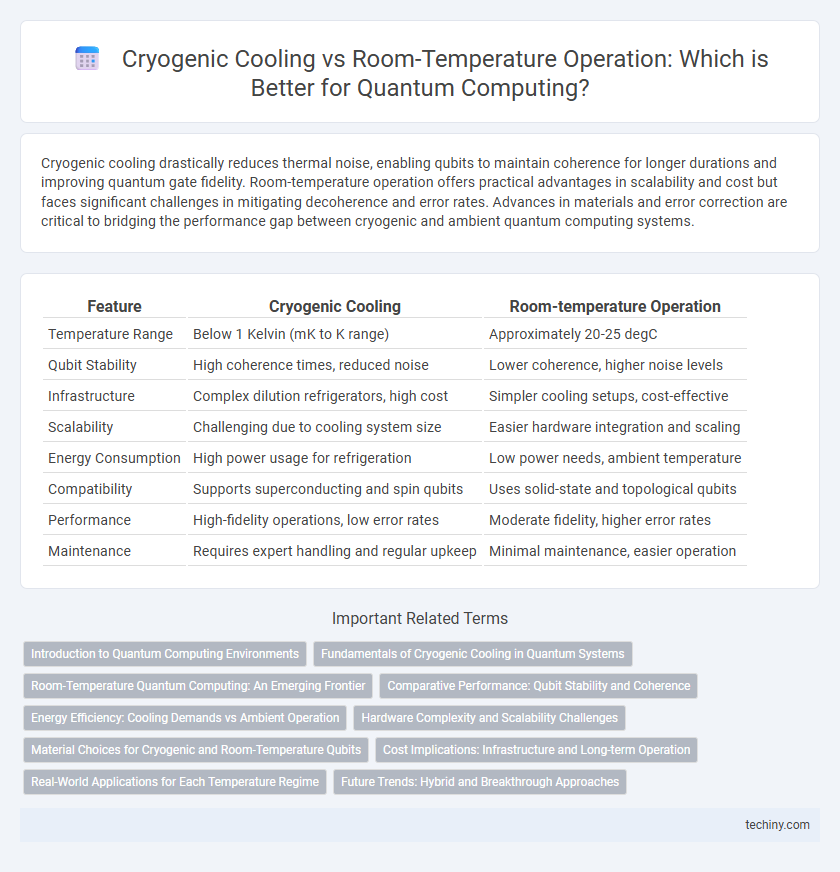Cryogenic cooling drastically reduces thermal noise, enabling qubits to maintain coherence for longer durations and improving quantum gate fidelity. Room-temperature operation offers practical advantages in scalability and cost but faces significant challenges in mitigating decoherence and error rates. Advances in materials and error correction are critical to bridging the performance gap between cryogenic and ambient quantum computing systems.
Table of Comparison
| Feature | Cryogenic Cooling | Room-temperature Operation |
|---|---|---|
| Temperature Range | Below 1 Kelvin (mK to K range) | Approximately 20-25 degC |
| Qubit Stability | High coherence times, reduced noise | Lower coherence, higher noise levels |
| Infrastructure | Complex dilution refrigerators, high cost | Simpler cooling setups, cost-effective |
| Scalability | Challenging due to cooling system size | Easier hardware integration and scaling |
| Energy Consumption | High power usage for refrigeration | Low power needs, ambient temperature |
| Compatibility | Supports superconducting and spin qubits | Uses solid-state and topological qubits |
| Performance | High-fidelity operations, low error rates | Moderate fidelity, higher error rates |
| Maintenance | Requires expert handling and regular upkeep | Minimal maintenance, easier operation |
Introduction to Quantum Computing Environments
Quantum computing environments require extremely low temperatures, often near absolute zero, to maintain qubit coherence and minimize quantum decoherence. Cryogenic cooling systems, such as dilution refrigerators, provide stable, ultra-cold environments essential for superconducting qubits and other sensitive quantum hardware. Room-temperature operation remains a significant challenge due to increased thermal noise, which disrupts quantum states and limits qubit performance and fidelity.
Fundamentals of Cryogenic Cooling in Quantum Systems
Cryogenic cooling is essential for quantum computing systems as it drastically reduces thermal noise, enabling qubits to maintain coherence and perform error-free operations. Superconducting qubits require temperatures near 10-20 millikelvin, achieved using dilution refrigerators, to sustain quantum states by minimizing decoherence from environmental interactions. Room-temperature operation faces significant challenges due to thermal fluctuations disrupting quantum coherence, making cryogenic environments critical for current quantum processors' stability and performance.
Room-Temperature Quantum Computing: An Emerging Frontier
Room-temperature quantum computing leverages advances in materials science and qubit design to overcome decoherence challenges typically mitigated by cryogenic cooling. Innovations in diamond-based nitrogen-vacancy centers and topological qubits aim to maintain quantum coherence without ultra-low temperatures, reducing complexity and operational costs. This emerging frontier promises scalable, energy-efficient quantum processors operable in standard environments, accelerating real-world quantum applications.
Comparative Performance: Qubit Stability and Coherence
Cryogenic cooling significantly enhances qubit stability and coherence times by reducing thermal noise and environmental disturbances, enabling error rates as low as 0.1%. Room-temperature operation faces challenges due to increased decoherence and shorter coherence times, typically limiting practical qubit performance to milliseconds or less. Advances in material science and error correction continue to narrow this gap, but cryogenic systems currently dominate high-fidelity quantum computing applications.
Energy Efficiency: Cooling Demands vs Ambient Operation
Cryogenic cooling in quantum computing requires significant energy input to maintain temperatures near absolute zero, often consuming multiple kilowatts to stabilize qubits. In contrast, room-temperature quantum devices eliminate these cooling demands, drastically reducing overall system energy consumption. However, challenges in qubit coherence and error rates at ambient temperatures still impact the balance between energy savings and computational reliability.
Hardware Complexity and Scalability Challenges
Cryogenic cooling systems for quantum computers demand intricate hardware setups and substantial energy consumption, posing significant scalability barriers. Room-temperature operation technologies reduce cooling infrastructure complexity but face challenges in maintaining quantum coherence and error rates. Balancing hardware complexity with efficient qubit performance remains a critical hurdle for large-scale quantum computing deployment.
Material Choices for Cryogenic and Room-Temperature Qubits
Material choices for cryogenic qubits often include superconducting metals like niobium and aluminum, which exhibit minimal electrical resistance at ultra-low temperatures, enabling coherent quantum states. Room-temperature qubits typically utilize diamond nitrogen-vacancy centers or silicon carbide, materials that maintain quantum coherence without requiring extreme cooling. Optimizing materials for each regime directly impacts qubit stability, coherence time, and scalability in quantum computing architectures.
Cost Implications: Infrastructure and Long-term Operation
Cryogenic cooling in quantum computing requires expensive infrastructure, including dilution refrigerators and advanced thermal management systems, driving up initial capital expenditure significantly. In contrast, room-temperature operation reduces upfront costs by eliminating the need for complex cooling hardware but may face challenges in maintaining quantum coherence efficiently. Long-term operational expenses for cryogenic systems include continuous power consumption and maintenance of ultra-low temperatures, while room-temperature systems offer potentially lower ongoing costs, pending advancements in stable qubit technologies.
Real-World Applications for Each Temperature Regime
Cryogenic cooling enables quantum computers to maintain qubit coherence by reducing thermal noise, making it crucial for high-fidelity quantum algorithms in cryptography and materials science simulations. Room-temperature operation, while currently limited by qubit stability, offers practical advantages in scalability and integration for quantum sensors and communication devices in real-world environments. Advances in solid-state qubits and error correction are steadily bridging the gap, expanding the scope of quantum computing beyond laboratory settings.
Future Trends: Hybrid and Breakthrough Approaches
Future trends in quantum computing highlight hybrid cryogenic and room-temperature systems to balance coherence time and practical scalability. Breakthrough developments include novel materials and error-correction algorithms enabling stable qubit operation closer to room temperature. These advancements aim to reduce cooling infrastructure complexity while maintaining qubit fidelity and processing power.
Cryogenic Cooling vs Room-temperature Operation Infographic

 techiny.com
techiny.com